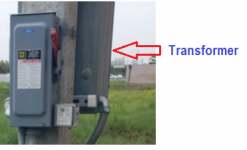Cjmccarthy
Member
- Location
- Florida
- Occupation
- Project Coordinator FDOT
So both the disconnect and transformer should go to the ground rod utilizing separate wires?Both the service disconnect and the transformer are required to be connected to the GES. The service neutral and the secondary neutral would also be bonded at their respective locations.
That is acceptable, a bonding jumper to the service GEC or any other electrode (when present) is also acceptableSo both the disconnect and transformer should go to the ground rod utilizing separate wires?
If the ground rod is the GES then both the transformer and the service disconnect must connect to it. As kwired stated there are several ways to do it.So both the disconnect and transformer should go to the ground rod utilizing separate wires?
Several ways??? Can we go from the disconnect to the ground rod and then bound the disconnect to the transformer? would that adhere to NEC?If the ground rod is the GES then both the transformer and the service disconnect must connect to it. As kwired stated there are several ways to do it.
on that pole there is a disconnect and behind it there is a transformer. sometimes the transformer could be a stepdown (from 600v to 240/480) sometimes is could be a step up. each location is a separately derived system for that location. So if I am understanding you correctly, the disconnect and the transformer needs to have a dedicated wire to ground rod, is that correct?I don't follow how the picture matches up to the plans. What kind of transformer is involved and what is the primary and secondary voltage? I don't see a transformer in the picture. Is it at the same structure as the service disconnect, or a separate structure?
Grounding a service and a separately derived system are separate issues. Everything at the same structure that needs to be grounded gets grounded to the same electrode system. Separate structures get separate electrode systems.
Bonding is also separate from grounding.

You can run a dedicated grounding electrode conductor from each OR you can run one from the disconnect and split bolt the one from the transformer to that one. (there are other options but that seems to be common here)on that pole there is a disconnect and behind it there is a transformer. sometimes the transformer could be a stepdown (from 600v to 240/480) sometimes is could be a step up. each location is a separately derived system for that location. So if I am understanding you correctly, the disconnect and the transformer needs to have a dedicated wire to ground rod, is that correct?
View attachment 2573069
Thank you, So if I go from the disconnect to the ground rod with say a #6 wire, then I can use a #6 wire from the disconnect buss bar to the transformer? I just want to make sure we adhere to NEC.You can run a dedicated grounding electrode conductor from each OR you can run one from the disconnect and split bolt the one from the transformer to that one. (there are other options but that seems to be common here)
No, you would go from the transformer to a split bolt in the GEC outside of the enclosures.Thank you, So if I go from the disconnect to the ground rod with say a #6 wire, then I can use a #6 wire from the disconnect buss bar to the transformer? I just want to make sure we adhere to NEC.
wouldn't it just be easier to have 2 wires, one from the disconnect and one from the transformer to the ground rod? The FDOT does not allow splits bolts, it would have to be CAD welded (Exothermic welding), that is what is acceptable to the Department.That transformer looked like the back of a panelboard to me.
No, you would go from the transformer to a split bolt in the GEC outside of the enclosures.
Think of it as...
You have a point on the service that you will ground. You have a point on the separately derived system that you will ground. These are both wires going to ground(ing electrodes), not to each other. They are allowed to join paths on the way to the ground,.i.e. tap to a common grounding electrode conductor. But they can also stay separate.
Do they also require exothermic weld connection to the rod?wouldn't it just be easier to have 2 wires, one from the disconnect and one from the transformer to the ground rod? The FDOT does not allow splits bolts, it would have to be CAD welded (Exothermic welding), that is what is acceptable to the Department.
Yes they do, per spec 620-2.5Do they also require exothermic weld connection to the rod?
I know sometimes certain authorities like to make these kind of rules but often with no real justification. IMO if the tap to the main GEC must be exothermic weld then it only makes sense to require the connection to the electrode itself to be exothermic weld. The current path is never better than it's weakest point.
When grounding a service point, do you ground the disconnect and bond the transformer, ground the transformer and bond the disconnect, ground both the disconnect and transformer or , does it matter? bellow is a picture of a site and the plans we want to make sure complies to NEC.
View attachment 2573068View attachment 2573067
View attachment 2573067
